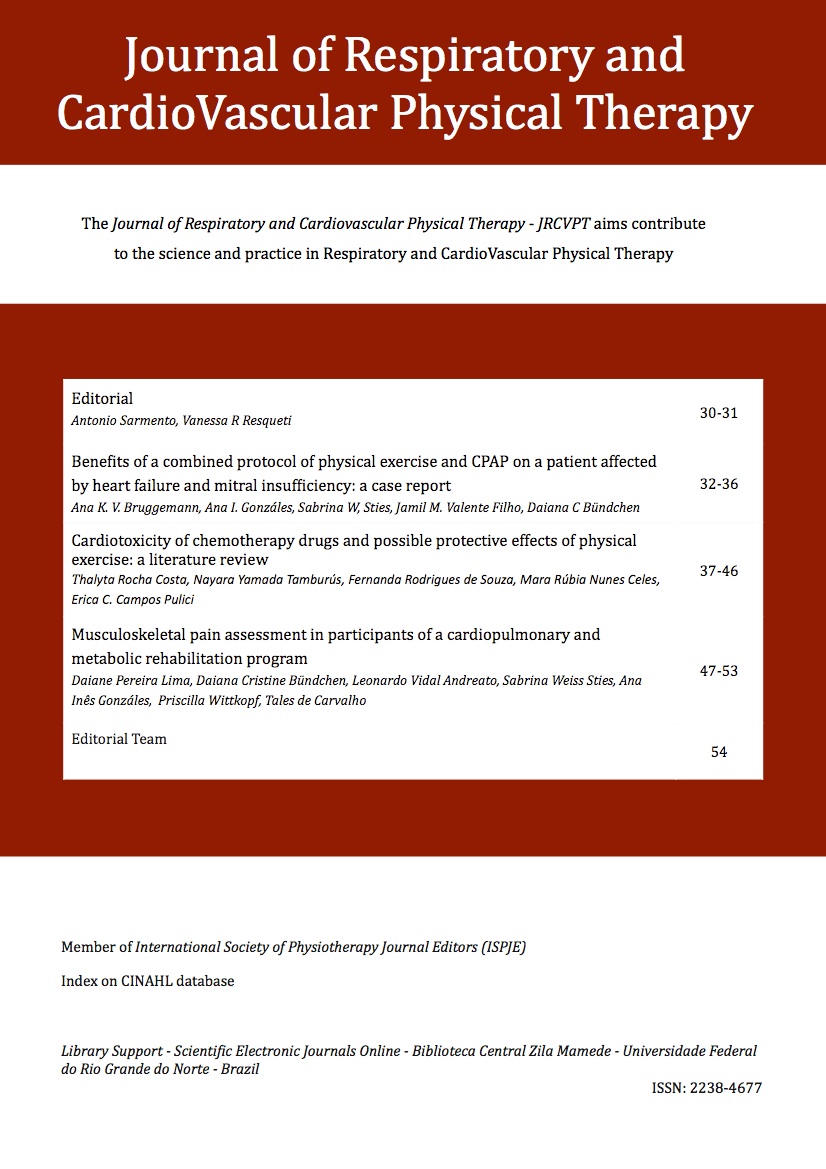Cardiotoxicity of chemotherapy drugs and possible protective effects of physical exercise: a literature review
Keywords:
Cardiotoxicity, doxorubicin, anthracyclines, cardiomyopathie, exerciseAbstract
This review was designed to summarize the main pathophysiological mechanisms of doxorubicin cardiotoxicity and the positive effects of physical exercise. Objective: To characterize a literature review on the main cardiotoxicity mechanisms already described and what possible strategies attenuate and/or prevent these side effects, with a focus on physical exercise. Methods: A literature search using PubMed (MEDLINE) and SciELO databases was conducted covering the articles published between 2000 and 2015. These studies were selected for posterior analysis, according to pre-established criteria. Results: Fifty-eight (58) articles based on references and according to the descriptors were found and 45 articles were included: 18 reviews, 19 articles developed with animal experiments, 07 articles with studies in humans and 01 guideline. Conclusion: Data analysis led us to understand that although there is no consensus about the doxorubicin mechanism of action that causes toxicity, the generation of reactive oxygen species and changes in intracellular calcium are the most studied mechanisms and provide the most evidence in literature. Other studies are still needed to elucidate the complex cardiotoxicity mechanisms and which strategies would be the best for cardioprotection. A possible therapeutic strategy that has been studied is implementing exercise, but some questions still arise, including: 1) What would be the best time to implement an exercise program, before or during chemotherapy? And 2) Could exercise play a cardioprotective role in preventing or attenuating toxic effects on the heart?
Downloads
Downloads
Additional Files
Published
How to Cite
Issue
Section
License
Copyright Transfer Statement
The author(s) of the article, as specified here, hereby transfer(s) to the Revista de Fisioterapia Respirtória e CardioVascular (Journal of Respiratory and CardioVascular Physical Therapy) all copyright ownership rights, title and interests that the author(s) may have or may come to have in and to the article and any revision or version thereof, including, but not limited to, exclusive right to print, publish and sell the article anywhere in the world, in any language and in any media.
This agreement will be considered effective and valid if and when the article is accepted for publication.
If the article contains any copyright-protected material from a third party, the author(s) must obtain written permission to reproduce the said material in the article from the copyright holder and send it to the Revista de Fisioterapia Respirtória e CardioVascular (Journal of Respiratory and CardioVascular Physical Therapy).
The author(s) guarantee(s) the holding of proprietary rights to the article; not having granted or transferred any rights to the article to any other persons or entity; that the article is susceptible to the demand for rights by its author(s); not having infringed upon any author rights, trademark or patent; not having violated the right to privacy or publicity of any person or entity; that the article does not contain any defaming subject; that the factual statements made are true or are based on reasonably accurate research; and, finally, that, the author(s) has/have no reason to believe that any of the formulas, procedures or prescriptions contained in the article will cause damage if used or followed in accordance with the instructions and warnings contained in the article.
The author(s) will indemnify the Revista de Fisioterapia Respirtória e CardioVascular (Journal of Respiratory and CardioVascular Physical Therapy) against any costs, expenses, damages or liability that the Revista de Fisioterapia Respirtória e CardioVascular (Journal of Respiratory and CardioVascular Physical Therapy) may incur as a result of accidental omissions of these guarantees. These representations and guarantees may be extended to a third party by the Revista de Fisioterapia Respirtória e CardioVascular (Journal of Respiratory and CardioVascular Physical Therapy).
Date:
Note: Each author must individually complete and sign this form
1) Author:
Signature: _________________________________
2) Author:
Signature: _________________________________
3) Author:
Signature: _________________________________
4) Author:
Signature: _________________________________
5) Author:
Signature: _________________________________
6) Author:
Signature: _________________________________
7) Author:
Signature: _________________________________
8) Author:
Signature: _________________________________




 English
English Español (España)
Español (España) Português (Brasil)
Português (Brasil) Français (Canada)
Français (Canada)